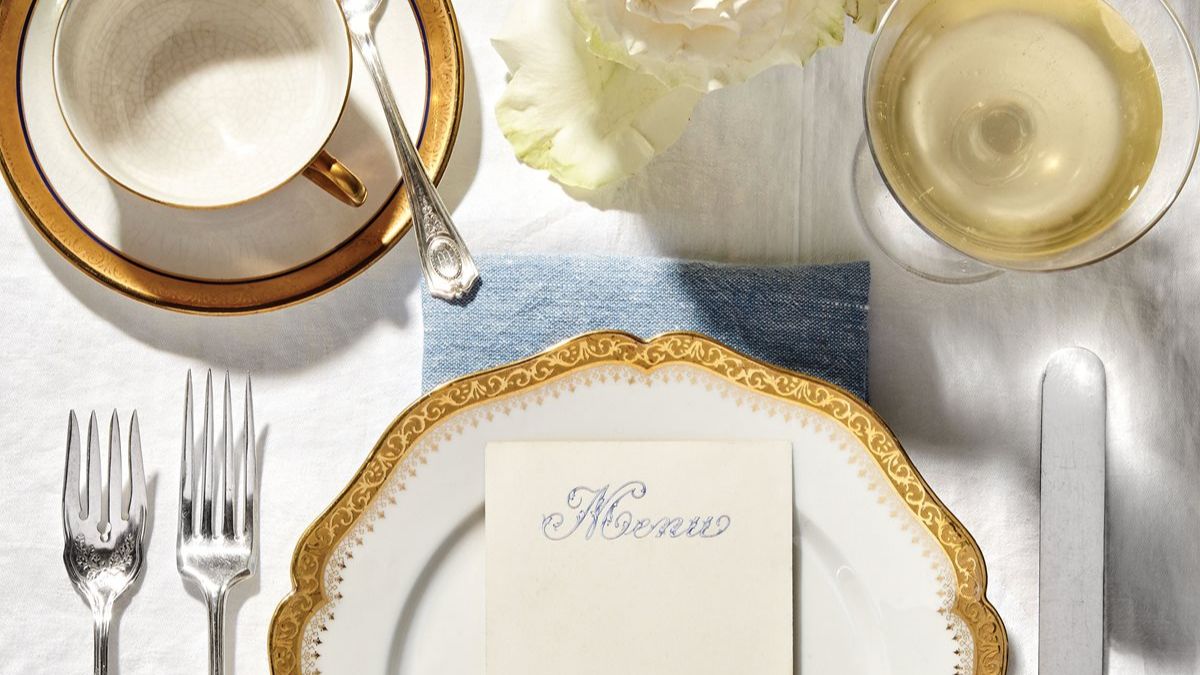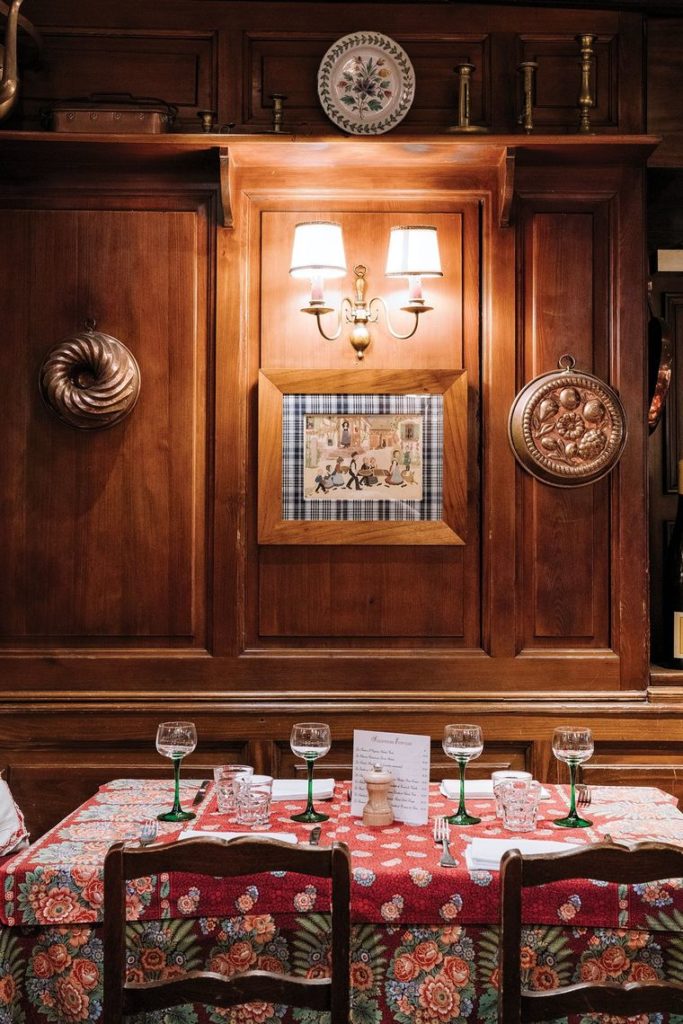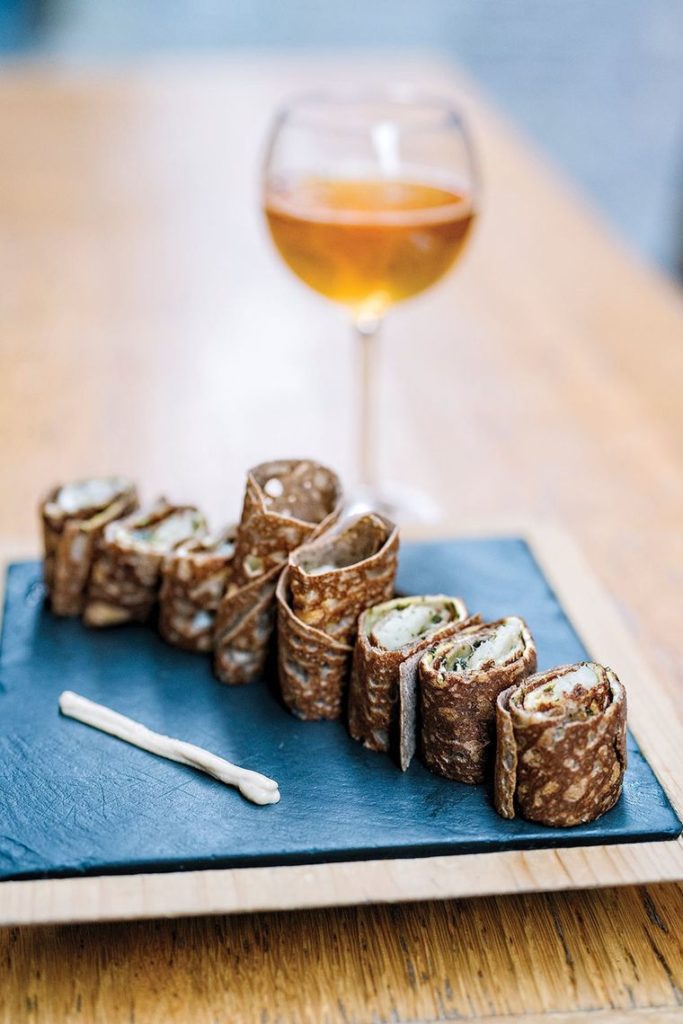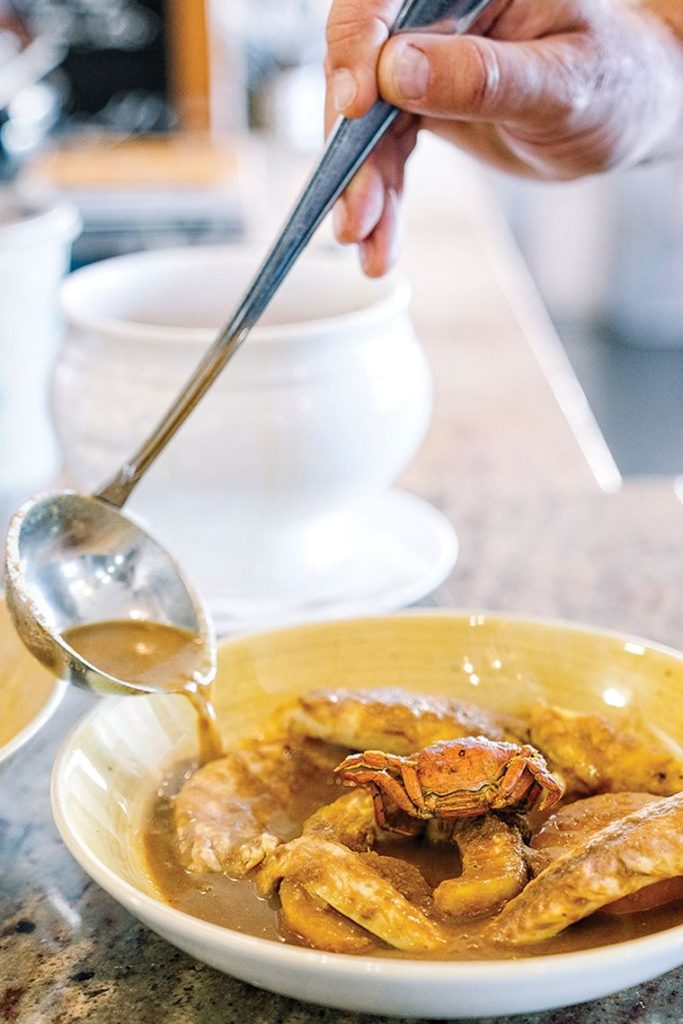Our Essential Guide to French Cuisine
February 20, 2021
Credit: Virtuoso

Chris Plavidal
Here’s what to eat in five French regions to kick off a culinary adventure.
Officially, France has only one national language. But considering how inextricably food and wine are tied to the country’s identity, gastronomy ranks a close second. While most cultures’ culinary heritage is integral to their characters, few have been as revered, both at home and abroad, as the amalgam of dishes and techniques that make up the French food vernacular. In fact, everything I’ve learned in my 12 years in France – about life, taste, and identity – I’ve learned around the table.
Central to that education: the importance of gathering with friends and family around food (while invariably discussing the next meal at length), and terroir, the idea that the singular combination of soil, weather, geography, and respect for the land influences and characterizes the flavors of everything from cheese to wine. It’s this idea that binds France’s 13 metropolitan regions and their specialties, from Brittany’s crispy buckwheat crepes to the briny fish stews of Provence.
Nothing can surpass the experience of trying classic French dishes – and those that represent the country’s immigrant diaspora – where they originate. While French tastes and techniques have evolved, the foundations of regional cooking endure.

Clara Tuma
Paris
When visitors come to Paris to eat, many seek out French food, a concept that implies a single, monolithic cuisine. In reality, dishes from across France and far beyond the country’s borders have become emblems of Parisian dining. Find them in bistros, brasseries, fine-dining restaurants, and, most recently, bouillons – working-class canteens specializing in inexpensive, nourishing, and ultra-simple dishes.
Experienced chefs have overhauled the best of the tried-and-true dishes, those locked in popular memory by the writings of culinary experts such as M.F.K. Fisher and Julia Child: steak-frites, leek-vinaigrette salad, poule au pot (bouillon-poached chicken with vegetables), veal blanquette, and oeuf mayonnaise (hard-boiled egg coated in homemade mayo, a bistro staple). Plan ahead and seek out the places that elevate these classics – which, unfortunately, are unlikely to be the average corner cafés.
As for contemporary dining, the city is brimming with neo-bistros influenced by the recent bistro boom that has rendered the Parisian dining experience more casual, from plate to decor, and more focused on progressive cooking, incorporating forgotten vegetables such as Jerusalem artichokes, turnips, and even kale; spices from Southeast Asia and the Middle East; and techniques that lighten the fare. These spots stick to what’s seasonal and fresh from the market each day. Head to the northeastern neighborhoods (the tenth, eleventh, twelfth, and nineteenth arrondissements), where these neo-bistros proliferate and where you’ll find all the other flavors and formats that characterize Parisian dining today, from pho joints to couscous restaurants and Israeli sandwich shops.
Top Tables
La Bourse et la Vie: Excellent steak-frites. Second arrondissement.
Mokonuts: Market-fresh cooking with a Lebanese twist. Eleventh arrondissement.
La Poule au Pot: For the namesake dish. First arrondissement.
Go: The northern neighborhood of Montmartre comes to life during a four-hour private walking tour led by Virtuoso on-site tour operator We Travel France. Travelers discover the local artisans, from fishmongers and cheese experts to butchers and bakers, who give the bohemian area its character and culinary bona fides. Most days (except Sundays and Mondays).
Alsace
Alsace is what many would call an “in-between” region. Located on France’s northeastern border, this fertile agricultural area between the Rhine and the Vosges Mountains yo-yoed between French and German control for centuries – a fact that marks its character and cuisine. That’s why you’ll find a distinctly Germanic spirit to Alsatian comforts, such as sausages, terrines, and choucroute garnie – sauerkraut seasoned with juniper berries, dill, fennel, chervil, horseradish, and wine, and topped with potatoes and a hefty pile of cured pork, from knackwurst to garlic sausages and bacon. And it’s all washed down with one of the region’s distinctive rieslings.
Another cross-cultural creation is the flammekueche (or tarte flambée in French), thin, pizzalike dough with crisp edges garnished with sliced onions, smoked lardons, and a light layer of crème fraîche (never call it an Alsatian pizza). In its sweet form, it’s often served with fruit, cinnamon, and Calvados. Where you indulge matters as much as the dishes themselves: Look for traditional winstubs, rustic wine pubs outfitted with red-checked tablecloths, wood paneling, and rough-hewn wooden tables, where specialties are served in earthenware pots.

Clara Tuma
Top Tables
Le Cerf: An upscale restaurant along the Alsatian wine route that serves refined classics. Marlenheim.
La Winstub du Chambard: Alsatian favorites revisited by a Michelin-starred chef. Kaysersberg.
Winstub Le Clou: An institution for simple, hearty Alsatian fare, including choucroute and fruit tarts. Strasbourg.
Go: Butterfield & Robinson’s six-day self-guided bike tour leads travelers right through the picturesque wine-making villages of Alsace. Cyclists pedal through the colorful towns of Kaysersberg, Riquewihr, and Ribeauvillé; take in unbeatable views along the Rhine; and unwind each night with a local dinner. Departures: Any day through 2020 (May through September suggested).
Brittany
If there’s a benefit to being isolated on France’s rugged westernmost coast, it’s the prime access to seafood and buckwheat, seemingly incongruous yet crucial components of the local cuisine. Green sea urchin and small but luscious rock and flat oysters thrive, thanks to the region’s high tidal range. While they vary in flavor according to provenance, oysters garner spots on menus everywhere – from the finest restaurants in Cancale, nicknamed “the oyster capital of France,” to the seafront market stalls in Riec-sur-Bélon, located in the southern part of the region.

Clara Tuma
Popularized in the area’s western tip of Finistère (meaning “land’s end”), savory crepes are known as galettes au blé noir (sometimes listed as au sarrasin) and made from buckwheat, introduced in the Middle Ages by Anne of Brittany to stave off starvation and ensure self-sufficiency. Lightly crisp on the edges, they’re often filled with modest pleasures, such as ham, cheese, and egg, but can be gussied up with a local catch or simplified with a smear of cultured Breton butter.
Top Tables
Le Comptoir Breizh Café: Modern takes on the buckwheat galette. Saint-Malo.
Le Coquillage: Celebrated chef Olivier Roellinger’s fine-dining temple of Breton seafood. Cancale.
Au Vieux Quimper: Legendary sweet and savory crepes – slightly different from the thicker galettes in other parts of Brittany – served in a rustic dining room. Quimper.
Go: The Emerald Coast’s dramatic landscapes and briny bites come into clear view on a six-day walking and hiking tour with Backroads. Travelers get a crash course in Breton culture and a taste of what makes this region unlike any other in France. Departures: Multiple dates, June 12 through October 2, 2020.
Burgundy
Some of the heartiest dishes that have come to define French food, from garlicky escargots and gougères (cheese puffs) to boeuf bourguignonne, a beef stew braised in red wine, have close ties to Burgundy (Bourgogne), a lush wine and agricultural region north of Lyon. Many of the country’s most decorated chefs hail from the area, running restaurants that honor Burgundy’s abundance of fine produce, meats, condiments (hello, Dijon mustard!), cheeses, and wines. Even poultry is put on a pedestal (and worth ordering when you see it): Not only is the poulet de Bresse widely considered the best chicken in the world, it’s the only one with AOC status.
Burgundy’s iconic local dishes have worldwide reach and still earn star treatment on menus across the region – whether they’re prepared traditionally or modernized in style or flavor. The jewel in the area’s culinary crown: coq au vin, another in the country’s arsenal of comforting stews. What began as a peasant dish of slow-cooked rooster (coq), simmered in local red wine and finished with carrots, sweet onions, and mushrooms, has been elevated to a national calling card, cooked in households all over France.
Top Tables
Le Relais Bernard Loiseau: The region’s most iconic, Burgundy-inspired cooking, with two-Michelin-starred service. Saulieu.
Le Bistro de l’Hôtel: A high-end ode to all the hearty classics, with a robust wine list (800 bottles!). Beaune.
Restaurant Greuze: Modern interpretations of local dishes and ingredients by one-Michelin-starred chef Yohann Chapuis. Tournus.
Go: Get a sense of Burgundy’s gastronomic heft during a few days in Beaune, a charming medieval town. Kensington Tours’ nine-day, privately led trip through Paris, Bordeaux, and Burgundy brings guests into the kitchen for a hands-on cooking experience and into the area’s famous wine cellars for exclusive tastings. Departures: Any day through 2020.
Provence
The sun-kissed region stretches from the southwestern edge of the Rhône River to the border of Italy, with foods that reflect the area’s terroir and diversity. Still, a few staples come to mind: le grand aioli, poached fish and raw vegetables with a freshly made aioli dip; ratatouille; stuffed vegetables called petits farcis; pissaladière – a kind of Niçoise pizza topped with onions and dressed with anchovies; daube de boeuf, a slow-baked stew similar to boeuf bourguignonne; and pan bagnat, like a salade Niçoise in a sandwich, served on a rustic round boule loaf (very picnic friendly).

Clara Tuma
A signature dish – one that Marseille locals rarely eat at restaurants, though they are fiercely proud of it – is bouillabaisse, a fish stew made from a mix of at least four varieties, such as rockfish, red mullet, monkfish, Saint Pierre (John Dory), or conger eel. Since locals disagree on what makes an authentic recipe, the versions offered at restaurants around the port city vary. What’s important is the combination of fish used, the quality of the rouille (the thick sauce made from red chilies, garlic, cayenne pepper, and breadcrumbs added to the dish), and the serving ritual: Waiters present the marinated fish to diners before they’re filleted and thrown into the pot. Two other Provençal dishes rival bouillabaisse for primacy: pizza and couscous, reflections of the palpable Neapolitan influence on the city, as well as its vibrant North African community.
Top Tables
Le Grand Bar des Goudes: Bouillabaisse served in a laid-back environment on the edge of the city. Marseille.
Pizza Charly: Legendary pie in the Noailles market. Marseille.
Le Riad: A favorite among locals for traditional Moroccan dishes, such as couscous with lamb and chicken tagine. Aix-en-Provence.
Go: During Luxury Gold’s ten-day jaunt, Francophiles take in Avignon’s medieval Old Town, the olive-oil mill of Les Baux-de-Provence, and the wines, artistic sites, architectural marvels, and foods that define the region. Departures: Multiple dates, April 25 through October 10, 2020.
French Dining Dos and Don’ts:
Virtuoso travel advisor Stephanie Fisher shares her takes on how not to look like a tourist in a French restaurant.
Do:
- Acknowledge staff with a “bonjour” or “bonsoir.”
- Eat when the French do: lunch between 12:30 and 2; dine after 8 p.m. at the earliest.
- Order the prix fixe menu. It’s the chef’s specials of the day and includes the freshest items from the market.
- Enjoy sitting close to another table, but don’t try to strike up a conversation – Parisians in particular don’t often do small talk.
- Have bread with your meal, but don’t ask for butter – it’s more of a breakfast item in France.
- Appreciate the pace of service: The staff aren’t ignoring you; they want you to enjoy your meal.
- Ask if the restaurant serves a simple green salad. Most do, and they are delicious.
- Dress for dinner – no athletic wear or leisure clothing. You can be chic in a cute pair of jeans, flats, and a nice top. Add a scarf and you’re ready to roll.
Don’t:
- Look for a kids’ menu. Children eat what adults eat in France.
- Ask for sauce on the side or request a substitution. In case of a serious allergy, carry a small card with relevant details written in French for the server to share with the chef.
- Request to split your check seven ways – work it out among your fellow diners.
- Expect your check unless you ask (“L’addition, s’il vous plaît”) – it’s considered rude to bring the bill until it’s requested.
Let Joyful Moments Become Lasting Memories
Experience the joy of learning, seeing, and doing together. Our well-traveled and well-connected team will guide you to the places, experiences, and people that will bring your destination to life. When it feels like time is just unspooling far too quickly, we’ll help you press “pause” and tap into all the wonders this world holds, all together. Immersive adventures and bond-building moments await.
HOME
COPYRIGHT © Insieme Luxury Travel 2020
DESIGNED BY GIRLBOSS DESIGNER
ABOUT
TRAVEL SERVICES
types of travel
CONTACT US
BLOG
Sign Up for Our Newsletter
Get to know Insieme Luxury Travel by subscribing to our newsletter. Receive inspiring destination highlights, luxury travel news, travel tips and much more!
Insieme Luxury Travel is an independent affiliate of Gifted Travel Network — a Virtuoso® Member.
Gifted Travel Network, Inc. is registered with the following State Licenses; California – Seller of Travel Registration No. 2113317 – 40;
Washington – Seller of Travel Unified Business ID (UBI) # 603 308 394; Florida – Seller of Travel Registration No. ST39093
Thank you!
You have successfully signed up for our newsletter.
*Don't forget to check your spam.
HISTORIC HOTELS
FAQS